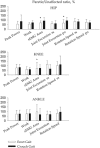Crouch gait can be an effective form of forced-use/no constraint exercise for the paretic lower limb in stroke
- PMID: 28574860
- PMCID: PMC5555972
- DOI: 10.1097/MRR.0000000000000236
Crouch gait can be an effective form of forced-use/no constraint exercise for the paretic lower limb in stroke
Abstract
In hemiplegic gait the paretic lower limb provides less muscle power and shows a briefer stance compared with the unaffected limb. Yet, a longer stance and a higher power can be obtained from the paretic lower limb if gait speed is increased. This supports the existence of a 'learned non-use' phenomenon, similar to that underlying some asymmetric impairments of the motion of the eyes and of the upper limbs. Crouch gait (CG) (bent-hip bent-knee, about 30° minimum knee flexion) might be an effective form of 'forced-use' treatment of the paretic lower limb. It is not known whether it also stimulates a more symmetric muscle power output. Gait analysis on a force treadmill was carried out in 12 healthy adults and seven hemiplegic patients (1-127 months after stroke, median: 1.6). Speed was imposed at 0.3 m/s. Step length and single and double stance times, sagittal joint rotations, peak positive power, and work in extension of the hip, knee, and ankle (plantar flexion), and surface electromyography (sEMG) area from extensor muscles during the generation of power were measured on either side during both erect and crouch walking. Significance was set at P less than 0.05; corrections for multiplicity were applied. Patients, compared with healthy controls, adopted in both gait modalities and on both sides a shorter step length (61-84%) as well as a shorter stance (76-90%) and swing (63-83%) time. As a rule, they also provided a higher muscular work (median: 137%, range: 77-250%) paralleled by a greater sEMG area (median: 174%, range: 75-185%). In erect gait, the generation of peak extensor power across hip, knee, and ankle joints was in general lower (83-90%) from the paretic limb and higher (98-165%) from the unaffected limb compared with control values. In CG, peak power generation across the three lower limb joints was invariably higher in hemiparetic patients: 107-177% from the paretic limb and 114-231% from the unaffected limb. When gait shifted from erect to crouch, only for hemiplegic patients, at the hip, the paretic/unaffected ratio increased significantly. For peak power, work, sEMG area, and joint rotation, the paretic/unaffected ratio increased from 55 to 85%, 56 to 72%, 68 to 91%, and 67 to 93%, respectively. CG appears to be an effective form of forced-use exercise eliciting more power and work from the paretic lower limb muscles sustained by a greater neural drive. It also seems effective in forcing a more symmetric power and work from the hip extensor muscles, but neither from the knee nor the ankle.
Figures





Similar articles
-
Effects of treadmill training with load addition on non-paretic lower limb on gait parameters after stroke: A randomized controlled clinical trial.Gait Posture. 2017 May;54:229-235. doi: 10.1016/j.gaitpost.2017.03.008. Epub 2017 Mar 10. Gait Posture. 2017. PMID: 28351743 Clinical Trial.
-
Contributions to the understanding of gait control.Dan Med J. 2014 Apr;61(4):B4823. Dan Med J. 2014. PMID: 24814597 Review.
-
Co-contraction around the knee and the ankle joints during post-stroke gait.Eur J Phys Rehabil Med. 2018 Jun;54(3):380-387. doi: 10.23736/S1973-9087.17.04722-0. Epub 2017 Aug 29. Eur J Phys Rehabil Med. 2018. PMID: 28849896
-
Biomechanical gait characteristics of naturally occurring unsuccessful foot clearance during swing in individuals with chronic stroke.Clin Biomech (Bristol). 2015 Dec;30(10):1102-7. doi: 10.1016/j.clinbiomech.2015.08.018. Epub 2015 Sep 2. Clin Biomech (Bristol). 2015. PMID: 26371855
-
Paretic propulsion as a measure of walking performance and functional motor recovery post-stroke: A review.Gait Posture. 2019 Feb;68:6-14. doi: 10.1016/j.gaitpost.2018.10.027. Epub 2018 Oct 25. Gait Posture. 2019. PMID: 30408710 Free PMC article. Review.
Cited by
-
Limping on split-belt treadmills implies opposite kinematic and dynamic lower limb asymmetries.Int J Rehabil Res. 2018 Dec;41(4):304-315. doi: 10.1097/MRR.0000000000000320. Int J Rehabil Res. 2018. PMID: 30303831 Free PMC article.
-
Gait analysis on force treadmill in children: comparison with results from ground-based force platforms.Int J Rehabil Res. 2017 Dec;40(4):315-324. doi: 10.1097/MRR.0000000000000243. Int J Rehabil Res. 2017. PMID: 28719477 Free PMC article.
-
Determinants of age-related decline in walking speed in older women.PeerJ. 2023 Mar 7;11:e14728. doi: 10.7717/peerj.14728. eCollection 2023. PeerJ. 2023. PMID: 36915651 Free PMC article.
-
Augmented Feedback in Post-Stroke Gait Rehabilitation Derived from Sensor-Based Gait Reports-A Longitudinal Case Series.Sensors (Basel). 2025 May 14;25(10):3109. doi: 10.3390/s25103109. Sensors (Basel). 2025. PMID: 40431901 Free PMC article.
-
Reversed Mirror Therapy (REMIT) after Stroke-A Proof-of-Concept Study.Brain Sci. 2023 May 24;13(6):847. doi: 10.3390/brainsci13060847. Brain Sci. 2023. PMID: 37371327 Free PMC article.
References
-
- Alexander RM, Jayes AS. (2009). A dynamic similarity hypothesis for the gaits of quadrupedal mammals. J Zool 201:135–152.
-
- Bamford J. (1992). Clinical examination in diagnosis and subclassification of stroke. Lancet 339:400–402. - PubMed
-
- Benjamini Y, Hochberg Y. (1995). Controlling the false discovery rate: a practical and powerful approach to multiple testing. J R Statist Soc B 57:289–300.
-
- Bolognini N, Vallar G, Casati C, Latif LA, El-Nazer R, Williams J, et al. (2011). Neurophysiological and behavioral effects of tDCS combined with constraint-induced movement therapy in poststroke patients. Neurorehabil Neural Repair 25:819–829. - PubMed
-
- Brandstater ME, de Bruin H, Gowland C, Clark BM. (1983). Hemiplegic gait: analysis of temporal variables. Arch Phys Med Rehabil 64:583–587. - PubMed
MeSH terms
LinkOut - more resources
Full Text Sources
Other Literature Sources
Medical
Research Materials

